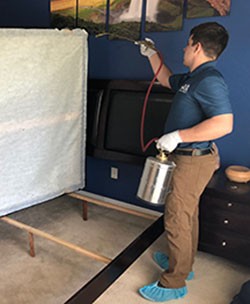Bed bugs are the hardest critters to kill if their history is anything to go by. Most people share the belief that pesticides are a fail-proof way of controlling these bothersome bugs. The truth, however, is that pesticides are not as effective as most people believe.
There are no magic pesticides that provide instantaneous positive results. Without knowledge on how to choose and apply pesticides, you are more likely to fail or cause harm to yourself. This post offers a comprehensive guide on pesticides that you can use to control bed bugs.
AUTHORS NOTE: We strongly discourage our readers against the use of Pesticides
Table of Contents
How to find ideal bed bug pesticides
Finding the ideal pesticide for your bed bug situation can be an uphill task if you don’t know where to look. Here are some ways to ease the process of finding an ideal option:
Using EPA’s pesticide search
The US Environmental Protection Agency (EPA) established an online search tool to search the ideal EPA-registered pesticides that fit your situation. The pesticides listed are available for use by any individual including those without professional training. It is, however, worth noting the product search tool does not offer any specific recommendations.
Bed bug situations tend to vary depending on various factors including the intensity of an infestation, and its location. When using the EPA’s search tool you must consider your situation’s specific needs. Here are some general guidelines to help you pick the most suitable pesticide:
- Only pick a product that serves your specific needs
- Don’t pick a product not approved for indoor-use if it’s not approved for that purpose
- Consider where you want to treat an infestation and adhere to the label directions
Consult the Cooperative extension service in your area
Cooperative extension service offices are situated across the USA but, most people know little about them and the services they offer. Lucky for you, Townhustle has got you covered. Cooperative extension services aim to serve communities by providing beneficial non-formal education.
The education offered by these entities is based on factual information obtained through research from Universities. Bed bugs are a huge problem across all 50 States. The cooperative extension service in your area is, therefore, likely in a position to advise you.
Stick to legally approved pesticides
Bed bugs tend to trigger panic upon their first sighting. Sometimes, you may be tempted to try illegal treatment methods in the hopes of getting rid of them faster. You must remember that sticking to legal treatment methods is the wise thing to do when dealing with bed bugs. Illegal treatment methods such as DDT will only land you in more trouble and burn a bigger hole in your pocket.
Using pesticides in the approved manner
Most pesticides pose serious health risks to you and your loved ones. We strongly encourage you to go for safe bed bug treatment methods or healthy organic products such as Diatomaceous Earth. That said, if you decide to stick with inorganic pesticides, you must be cautious when using them. Here are some guiding principles on how to handle pesticides:
- Select a pesticide labeled for indoor use if you intend to use it indoors
- Ensure that your chosen product is labeled to be effective against bed bugs
- Never apply more pesticide than is recommended in the usage instructions
- Avoid using pesticides on mattresses and beddings. Sleeping gear present a greater risk of exposure to harmful chemicals.
How Pesticides Work?
There are different chemical classes of pesticides. Each class kills bed bugs using a distinct mode of action. Some mode of actions include:
- Drying out the bug’s exoskeleton
- Attacking the nervous system
- Interfering with the growth process
It is advisable to combine pesticides with different modes of action because they minimize the likelihood of resistance. We shall discuss the different modes of action in depth when looking at the chemical classes of pesticides.
Chemical classes of bed bug pesticides
The Environmental Protection Agency registry boasts of over 300 pesticides to control bed bugs. These products are classified into different chemical classes discussed as follows:
Pyrethrins
Pyrethrins are botanical pesticides obtained from chrysanthemum flowers. This chemical class of pesticides works by altering the activity of sodium ion channels of the bed bug’s nerves. The result of this action is repetitive nerve firing and subsequent death of the bug.
Pyrethrins are, however, not as effective has most belief because bed bugs have developed some resistance to the nerve damaging toxins. It is also worth noting that Pyrethrins can harm humans and pets if used in high doses.
If you choose to use Pyrethrins-based pesticides, you must remember that they have a shelf-life of about 2 years. This depends on your compliance to the manufacturer’s storage instructions. Storing pesticides in extreme temperatures contrary to the manufacturers instruction can lead to pesticide deterioration.
Pyrethroids
Pyrethroids are synthetic chemical pesticides that work in the same manner as Pyrethrins. They attack the central nervous system by interacting with sodium channels in the bug’s neurons. Bed bugs have, nonetheless, developed some resistance to this chemical, reducing its effectiveness. Like Pyrethrins and other chemicals, it poses some risks to human and animal health.
Desiccants
A desiccant is a hygroscopic substance that induces a state of dryness. You can find diatomaceous earth (DE) and silica gel among the desiccants. This class of chemical pesticide destroys the waxy exoskeleton of a bed bug. Once this happens, the bed bug will dehydrate gradually and die.
Modern bed bugs have, however, developed thicker and waxier exoskeletons, rendering desiccants less effective. You must also remember that non-food grade desiccants pose serious inhalation risks.
Biochemicals
Biochemical pesticides are derived from naturally occurring substances that have the capacity to control pests. Cold pressed neem oil is currently the only EPA-registered biochemical pesticide for bed bugs. Neem oil can only kill bed bugs it comes in contact with making it less effective.
Pyrroles
Pyrroles are heterocyclic aromatic organic compounds. They work by interfering with the bug’s ability to produce energy in its cells. Without energy to perform various actions such as movement and feeding, the bed bug dies. Chlorfenapyr is the only EPA-registered pyrrole.
Neonicotinoids
Neonicotinoids are artificial forms of nicotine that work by attacking the bed bug’s nerves. They act on the nicotinic receptors of the nervous system. This action causes the nerves to fire and eventually fail, causing death.
Insect growth regulators
This class of chemical pesticides simulates juvenile bed bug growth hormones. Their mode of action is interfering with the production of Chitin, the compound responsible for the bed bug’s exoskeleton. Without developing and shading its exoskeleton, a bed bug cannot move to its next stage of growth. Hydropropene, an artificial juvenile hormone look-alike that disrupts pests’ normal growth pattern, is an excellent example of an insect growth regulator.
Pesticide classification by delivery method
There are several methods you can use to deliver pesticides during a bed bug treatment process. Here is a discussion of common pesticide delivery methods used in modern society:
Aerosol spray
An aerosol spray uses a liquefied liquid propellant to deliver pesticides to an intended target. This method of delivery leaves behind chemical residues that are meant to kill bed bugs long after the pesticide dries.
For a bed bug to die, it needs on the dried residue for several days. A bed bug seldom stay in one position long enough to absorb chemical residue to kill it, rendering aerosol sprays ineffective.
Repellant plates and traps
Repellant plates and traps work to keep bed bugs away rather than kill them. These methods serve more as tools to monitor bed bug infestations. You should only apply them as a means to watch for bed bugs and not to wipe out full-blown infestations.
Foggers
Foggers, famously known as ‘bug bombs,’ often use Pyrethroids. This pesticide delivery method is often the cause of explosions and several house fires. They also scatter pesticides over a large area thus, exposing you and your loved ones to various health hazards. Foggers are ineffective in controlling bed bugs owing to a number of reasons including:
- They cannot reach crevices and cracks where most bed bugs hide
- Bed bugs don’t like the residue and are likely to seek refuge in other untreated spaces, spreading the infestation.
Insecticide dusts
There are several insecticide types that can help to control pests but, only a few, work on bed bugs. Inorganic dusts pose several health hazards while others do not. Here are some common insecticide dusts worth noting:
Diatomaceous earth
Diatomaceous earth is an organic pesticide that falls on the desiccant chemical class of pesticides. Its mode of action is the destruction of the bed bug’s exoskeleton, subjecting it to dehydration and subsequent death. Food-grade diatomaceous earth is recommended as a bed bug treatment method because it is safe and relatively effective.
Boric Acid
Boric acid is often recommended to fight bed bug infestations. Bed bugs have to ingest it to work and since they only consume blood, it is not an effective control method. Boric acid is also poisonous to humans and pets.
Silica gel dust
Silica dust is a white, powdered form of silicon dioxide. Its mode of action is dehydration of the bug’s exoskeleton, leading to death. Silica gel is too lightweight so, you have to mix it with a petroleum distillate for it to stick to the treatment surface. Silica gel is a much better long-term solution than most of pesticides.
Effectiveness of pesticides in controlling bed bugs
The effectiveness of bed bugs in controlling bed bugs has reduced over the years as these tiny critters continue to evolve. According to a recent report, bed bugs have developed resistance to pesticides. Some of the evolutionary mechanisms facilitating this resistance include thickening of the exoskeleton, kdr mutations, and increased metabolism.
To kill bed bugs today, you need 1000 times the concentration of pesticides that would eliminate a non-resistant insect. Such a concentration of chemicals is hazardous to humans and pets. Scientists therefore, advocate for non-chemical treatment methods such as heat treatment.
Final Thoughts
Most of us trust and depend on pesticides as an effective means of controlling bed bugs. If you are one of them, I hope this post will open your mind to the new reality. Pesticides are no longer as effective as they were seven decades ago. It is wise for you to look up and employ alternative, non-chemical bed bug control methods.
Frequently Asked Questions
Which is the best pesticide to control bed bugs?
Pyrethrins and Pyrethroids are the most common compounds used in controlling bed bugs. The truth, however, is that pesticides are not effective in controlling bed bugs. It would be wise to employ alternative, non-chemical control methods.
Do pesticides kill bed bugs immediately?
Most pesticide manufacturers claim that their products immediately. The truth is that pesticides can take from 2 hours to several days depending on several factors. Some of the factors include the concentration of the pesticide, intensity of the infestation, and the room’s condition.
Are pesticides safe for human beings?
No pesticides contain chemical compounds that pose serious health hazards especially when used in large amounts. Some pesticides can even be dangerous in small quantity; it’s why EPA is regulating the use of pesticides.
Which pesticide should I use to kill bed bugs eggs?
Pesticides are not effective in killing bed bugs eggs. The best method of killing bed bug eggs is heat treatment at temperatures of 118°F (48°C) for 90 minutes.

